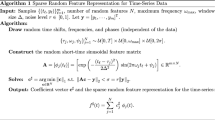Abstract
This paper presents an effective correlation vectored taxonomy algorithm to compute highly concentrated time-frequency distributions (TFDs) using localized neural networks (LNNs). Spectrograms and pre-processed Wigner–Ville distributions of known signals are vectorized and clustered as per the elbow criterion to constitute the training data for multiple artificial neural networks. The best trained networks become part of the LNNs. Test TFDs of unknown signals are then processed through the algorithm and presented to the LNNs. Experimental results demonstrate that appropriately vectored and clustered data once processed through the LNNs produce high resolution TFDs. Examples are presented to show the effectiveness of the proposed algorithm via analysis based on entropy and visual interpretation.
Similar content being viewed by others
References
Ahmad, J., Shafi, I., Shah, S.I., Kashif, F.M., Analysis and Comparison of Neural Network Training Algorithms for the Joint Time-Frequency Analysis, Proc. IASTED Intl. Conf. on Artificial Intelligence and Applications, pp. 193–198, Austria, Feb. 2006.
Akan, A., Signal-Adaptive Evolutionary Spectral Analysis Using Instantaneous Frequency Estimation, FREQUENZ Journal of RF-Engineering and Telecommunications, Vol. 59, No. 7–8/2005, pp. 201–205, 2005.
Akan, A., Chaparro, L.F., Evolutionary Chirp Representation of Non-stationary Signals via Gabor Transform, Signal Processing, Vol. 81, No. 11, pp. 2429–2436, 2001.
Baraniuk, R.G., Jones, D.L., Signal-Dependent Time-Frequency Analysis Using a Radially Gaussian Kernel, IEEE Trans. Signal Processing, Vol. 32, pp. 263–284, 1993.
Barbarossa, S., Analysis of Multicomponent LFM Signals by a Combined Wigner–Hough Transform, IEEE Trans. Signal Processing, Vol. 46, No. 6, pp. 1511–1515, 1995.
Barkat, B., Abed-Meraim, K., Algorithms for Blind Components Separation and Extraction from the Time-Frequency Distribution of Their Mixture, EURASIP Journal on Applied Signal Processing, Vol. 2004, No. 13, pp. 2025–2033, 2004.
Basu, M., Su, M., Deblurring Images Using Projection Pursuit Learning Network, IEEE Trans. Signal Processing, 1999.
Boashash, B., Time-Frequency Signal Analysis and Processing: A Comprehensive Reference, Elsevier, Oxford, UK, 769 pages, 2003.
Chaparro, L.F., Suleesathira, R., Akan, A., Unsal, B., Instantaneous Frequency Estimation Using Discrete Evolutionary Transform for Jammer Excision, Proc. ICASSP ’01, Vol. 6, pp. 3525–3528, 7–11 May 2001.
Chauvin, Y., Rumelhart, D.E., Back Propagation: Theory, Architecture, and Applications, Lawrence Erlbaum Associates, Hillsdale, NJ, 1995.
Cohen, L., Time Frequency Analysis, Prentice-Hall, Englewood Cliffs, NJ, 1995.
Emresoy, M.K., Loughlin, P.J., Weighted Least Square Cohen-Posch Time-Frequency Distribution Functions, IEEE Trans. Signal Processing, Vol. 46, No. 3, pp. 753–757, 1998.
Gray, R.M., Entropy and Information Theory, Springer, New York, 1990.
Groutage, D., A Fast Algorithm for Computing Minimum Cross-Entropy Positive Time-Frequency Distributions, IEEE Trans. Signal Processing, Vol. 45, No. 8, pp. 1954–1970, 1997.
Hagan, M.T., Demuth, H.B., Beale, M., Neural Network Design, Thomson Learning USA, Boston, MA, 1996.
LJubisa, S., Vladimir, K., Algorithm for the Instantaneous Frequency Estimation Using Time-Frequency Distributions with Adaptive Window Width, IEEE Signal Processing Letters, Vol. 5, No. 9, pp. 224–227, 1998.
MacKay, D.J.C., A Practical Bayesian Framework for Back Propagation Network, Neural Computation, Vol. 4, No. 3, pp. 448–472, 1992.
Pitton, J.W., Positive Time-Frequency Distributions via Quadratic Programming, Journal of Multidimensional Systems and Signal Processing, Vol. 9, No. 4, pp. 439–445, 1998.
Pitton, J., Loughlin, P., Atlas, L., Positive Time-Frequency Distributions via Maximum Entropy Deconvolution of the Evolutionary Spectrum, Proc. ICASSP ‘93, Vol. IV, pp. 436–439, 1993.
Shafi, I., Ahmad, J., Shah, S.I., Kashif, F.M., Impact of Varying Neurons and Hidden Layers in Neural Network Architecture for a Time Frequency Application, Proc. 10th IEEE Intl. Multi Topic Conf., INMIC 2006, Islamabad, Pakistan, 23–24 Dec. 2006.
Shah, S.I., Loughlin, P.J., Chaparro, L.F., El-Jaroudi, A., Informative Priors for Minimum Cross-Entropy Positive Time Frequency Distributions, IEEE Signal Processing Letters, Vol. 4, No. 6, pp. 176–177, 1997.
Slueesathira, R., Chaparro, L.F., Akan, A., Discrete Evolutionary Transform for Positive Time Frequency Signal Analysis, Journal of Franklin Institute, Vol. 337, No. 4, pp. 347–364, 2000.
Stankovic, L., Highly Concentrated Time-Frequency Distributions: Pseudo Quantum Signal Representation, IEEE Trans. Signal Processing, Vol. 45, No. 3, pp. 543–551, 1997.
Suleesathira, R., Chaparro, L.F., Interference Mitigation in Spread Spectrum Using Discrete Evolutionary and Hough Transforms, Proc. ICASSP ’00, Vol. 5, pp. 2821–2824, 5–9 June 2000.
Yagle, A.E., Torres-Fernandez, J.E., Construction of Signal-Dependent Cohen’s-class time-frequency distributions using iterative blind deconvolution, Proc. SPIE, Advanced Signal Processing Algorithms, Architectures, and Implementations XIII. Edited by Luk, Franklin T., Vol. 5205, pp. 47–58, 2003.
Author information
Authors and Affiliations
Corresponding author
Additional information
This work was supported by the Higher Education Commission (HEC) of Pakistan under the 200 Merit Scholarship Scheme.
Rights and permissions
About this article
Cite this article
Shafi, I., Ahmad, J., Shah, S.I. et al. Computing Deblurred Time-Frequency Distributions Using Artificial Neural Networks. Circuits Syst Signal Process 27, 277–294 (2008). https://doi.org/10.1007/s00034-008-9027-x
Received:
Revised:
Published:
Issue Date:
DOI: https://doi.org/10.1007/s00034-008-9027-x




